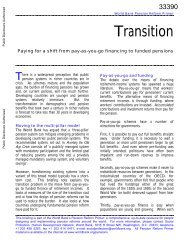Financial Sector Development in Africa: Opportunities ... - World Bank
Financial Sector Development in Africa: Opportunities ... - World Bank
Financial Sector Development in Africa: Opportunities ... - World Bank
You also want an ePaper? Increase the reach of your titles
YUMPU automatically turns print PDFs into web optimized ePapers that Google loves.
96 Coates and Hofmeister<br />
Technical assistance <strong>in</strong> buyer and supplier f<strong>in</strong>ance. In some cases, technical<br />
assistance <strong>in</strong> develop<strong>in</strong>g and market<strong>in</strong>g a buyer/supplier f<strong>in</strong>ance<br />
product is recommended. The nature of the assistance needed depends<br />
very much on the market. For example, many commercial bankers will<br />
not need assistance with the concept of the product, but <strong>in</strong>stead they will<br />
f<strong>in</strong>d challenges <strong>in</strong> the know-how required to commercialize the product.<br />
Consult<strong>in</strong>g and assistance are likely to be more helpful <strong>in</strong> mak<strong>in</strong>g the<br />
bus<strong>in</strong>ess case than practical implementation, with which they are well<br />
equipped to deal without outside assistance. This chapter advocates the<br />
identification of best-practice case studies of buyer and supplier agricultural<br />
f<strong>in</strong>ance <strong>in</strong> other markets (for example, Lat<strong>in</strong> America or South and<br />
East Asia, Eastern Europe, or even OECD countries—those <strong>in</strong> the<br />
Organisation for Economic Co-operation and <strong>Development</strong>). It also<br />
advocates the promotion of field visits by senior bank<strong>in</strong>g executives to see<br />
how a product is work<strong>in</strong>g on the ground and to quiz senior-level counterparts<br />
on the value of the product to their bank<strong>in</strong>g offer.<br />
Additionally, although most <strong>Africa</strong>n bankers are capable of grasp<strong>in</strong>g<br />
the product, the banks themselves are often much less sophisticated.<br />
They may struggle with <strong>in</strong>stitutional problems and are likely to require<br />
more broad-based support to br<strong>in</strong>g their <strong>in</strong>stitutions up to the basic levels<br />
required for this type of product.<br />
Other Approaches to Release Work<strong>in</strong>g Capital<br />
We have chosen to expand more fully on buyer and supplier f<strong>in</strong>ance<br />
arrangements both because they serve as useful examples to illustrate<br />
how the relationships among banks, agribus<strong>in</strong>ess, and producers tend to<br />
work and because these products rarely need any further development of<br />
f<strong>in</strong>ancial sector <strong>in</strong>frastructure or the legal and regulatory environment.<br />
However, other extremely viable and <strong>in</strong>terest<strong>in</strong>g alternatives can certa<strong>in</strong>ly<br />
be used to expand or release work<strong>in</strong>g capital for agricultural value cha<strong>in</strong>s<br />
if the circumstances are right.<br />
One option currently be<strong>in</strong>g explored is the use of warehouse receipts,<br />
which are <strong>in</strong> relatively common use <strong>in</strong> some other markets. Under this<br />
arrangement, commoditized produce (for example, wheat, coffee, cocoa,<br />
maize) is deposited <strong>in</strong> a warehouse by the owner and a receipt is issued<br />
aga<strong>in</strong>st it. This receipt stipulates the quantity, quality, and type of produce<br />
deposited. The warehouse receipt is generally negotiable, mean<strong>in</strong>g ownership<br />
is transferable, mak<strong>in</strong>g it quite suitable for collateral. Therefore,<br />
f<strong>in</strong>ancial <strong>in</strong>stitutions have proved will<strong>in</strong>g to extend loans aga<strong>in</strong>st this<br />
security <strong>in</strong> the right environment.







